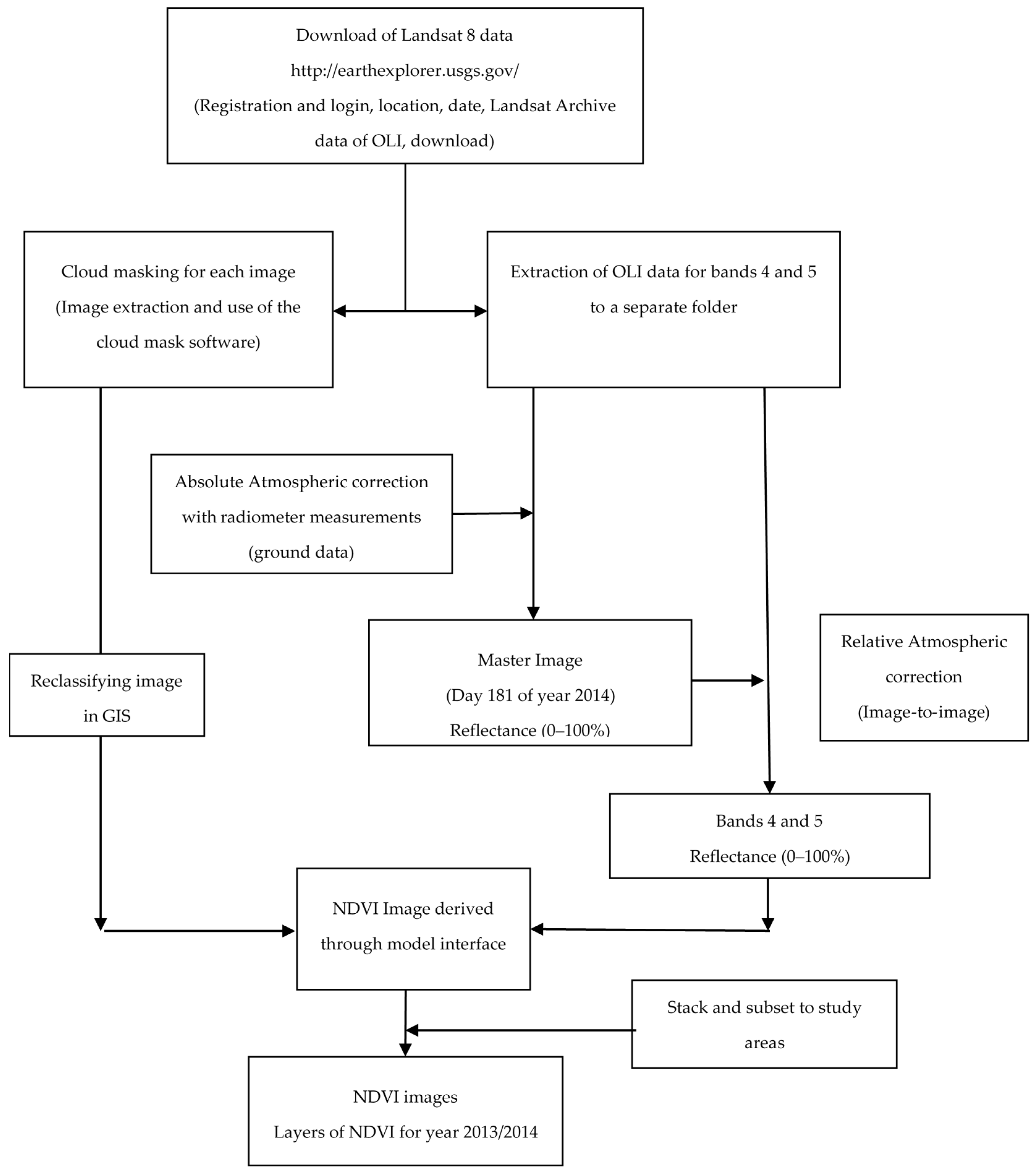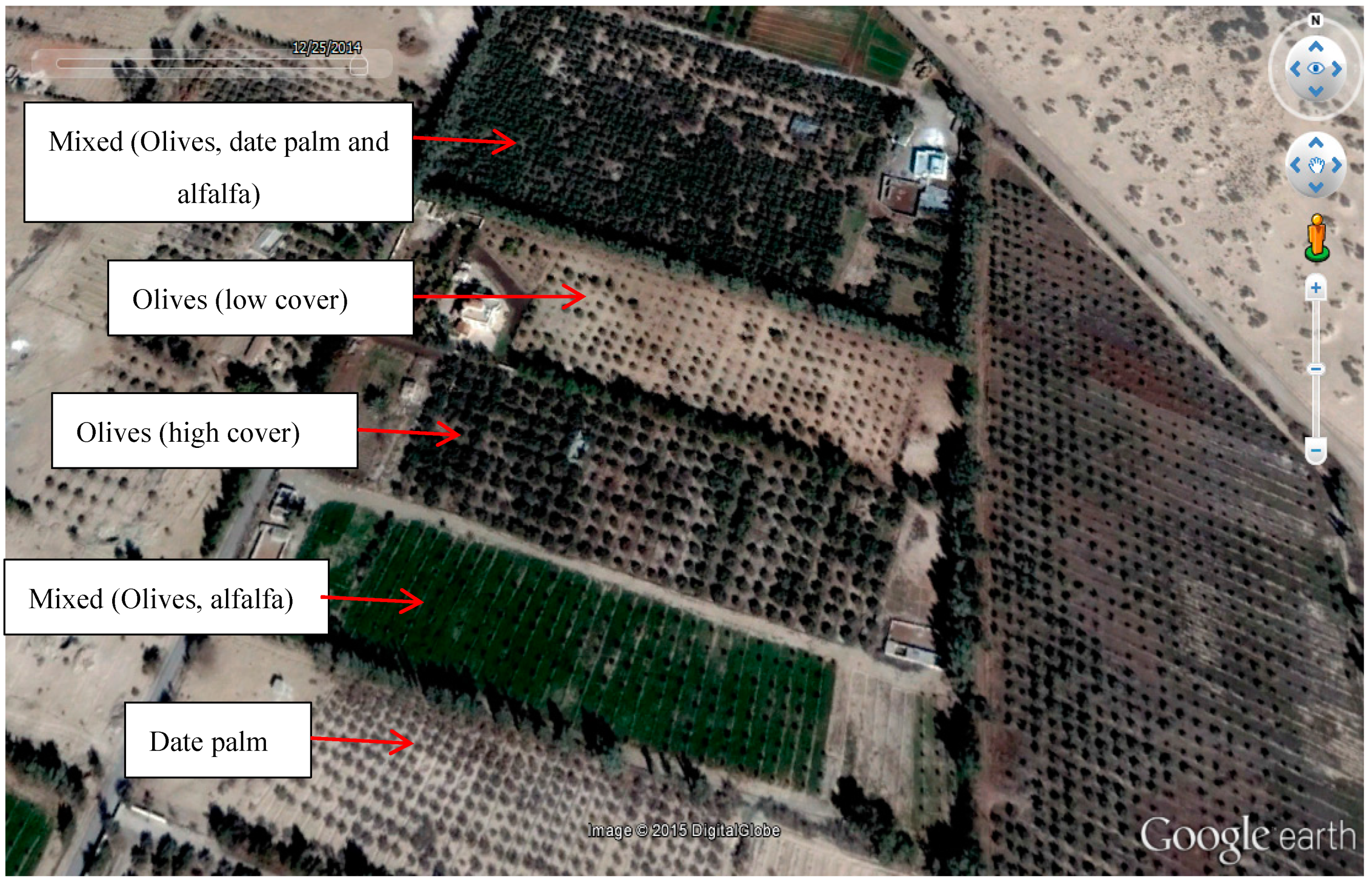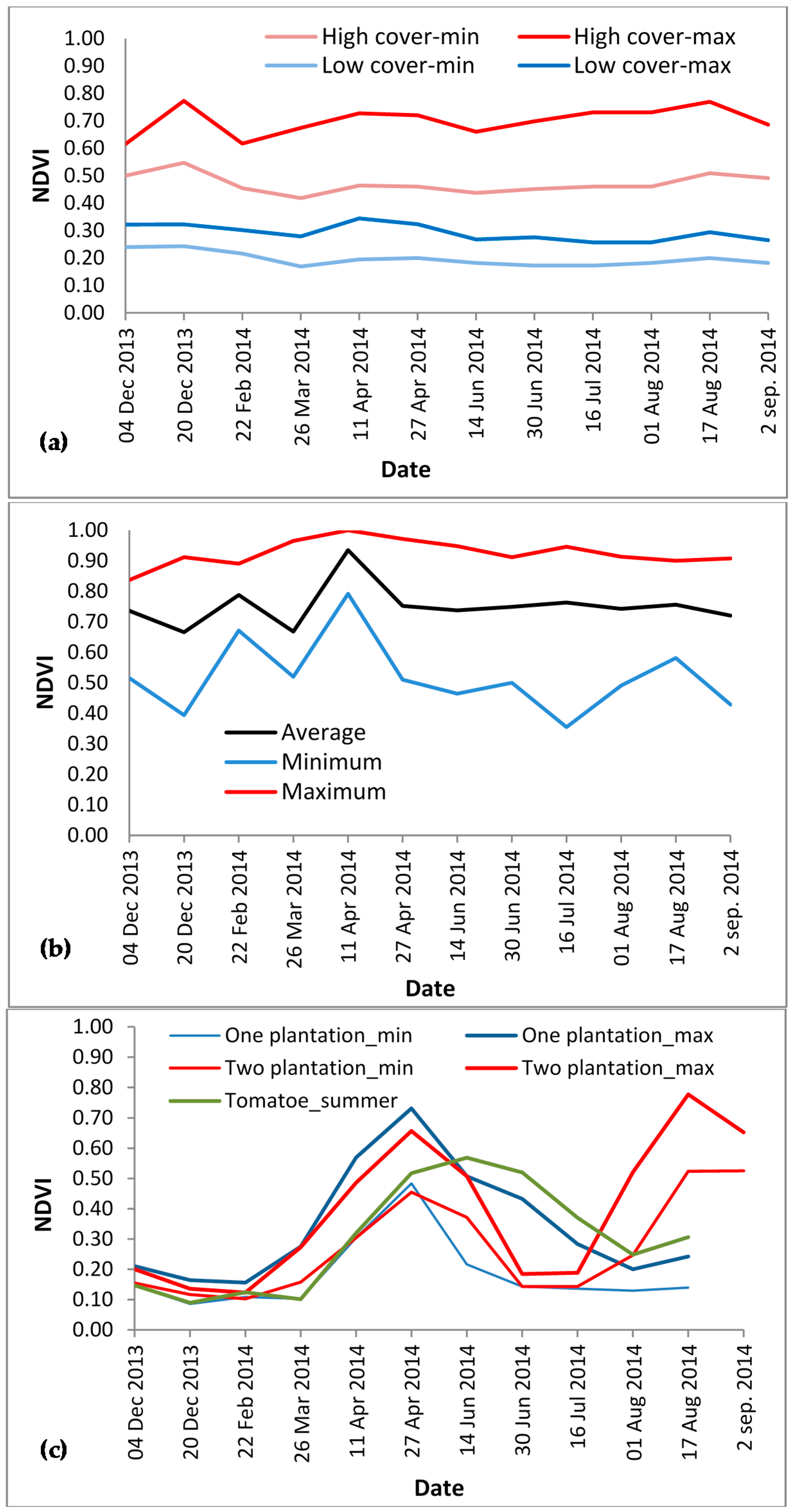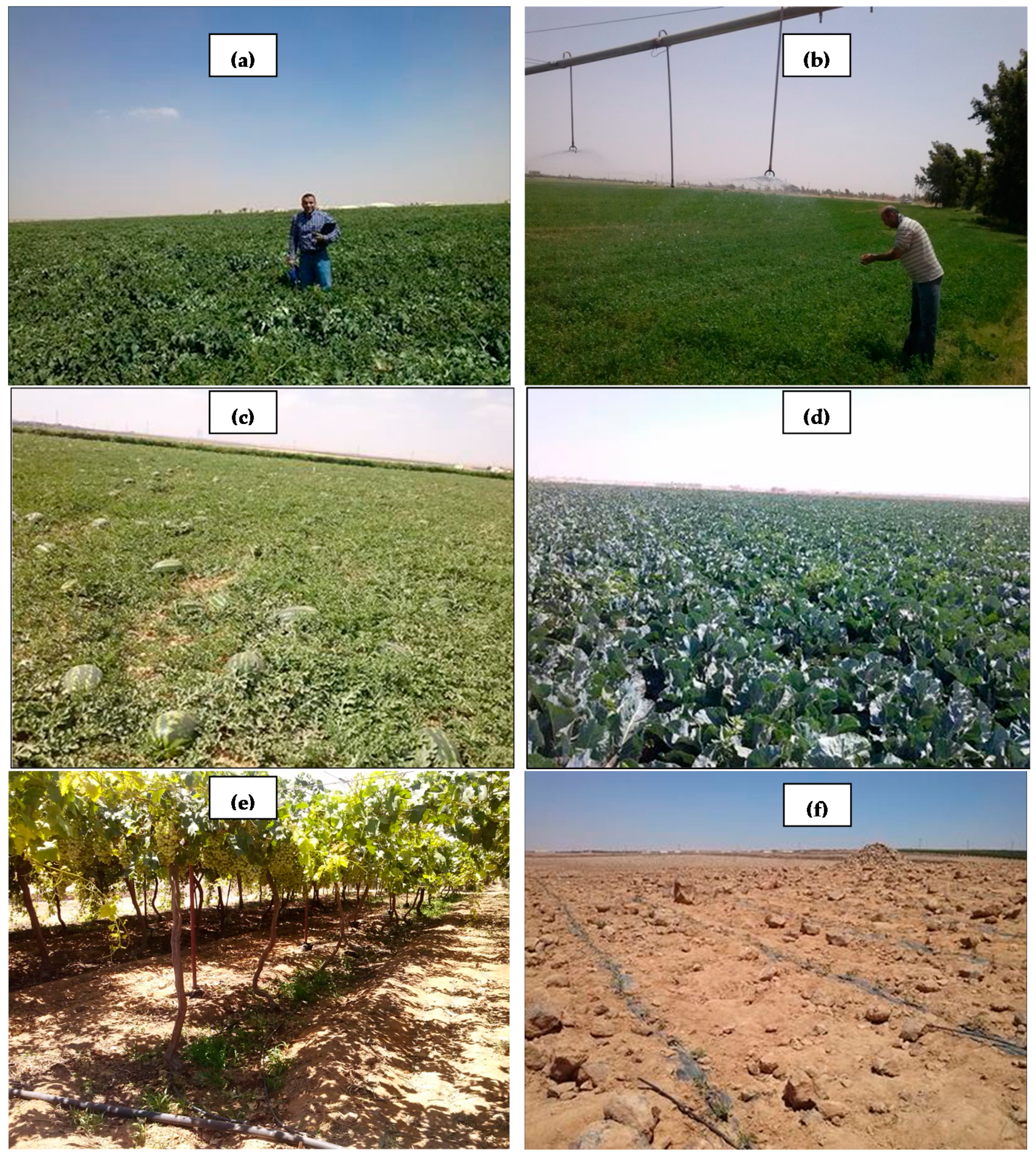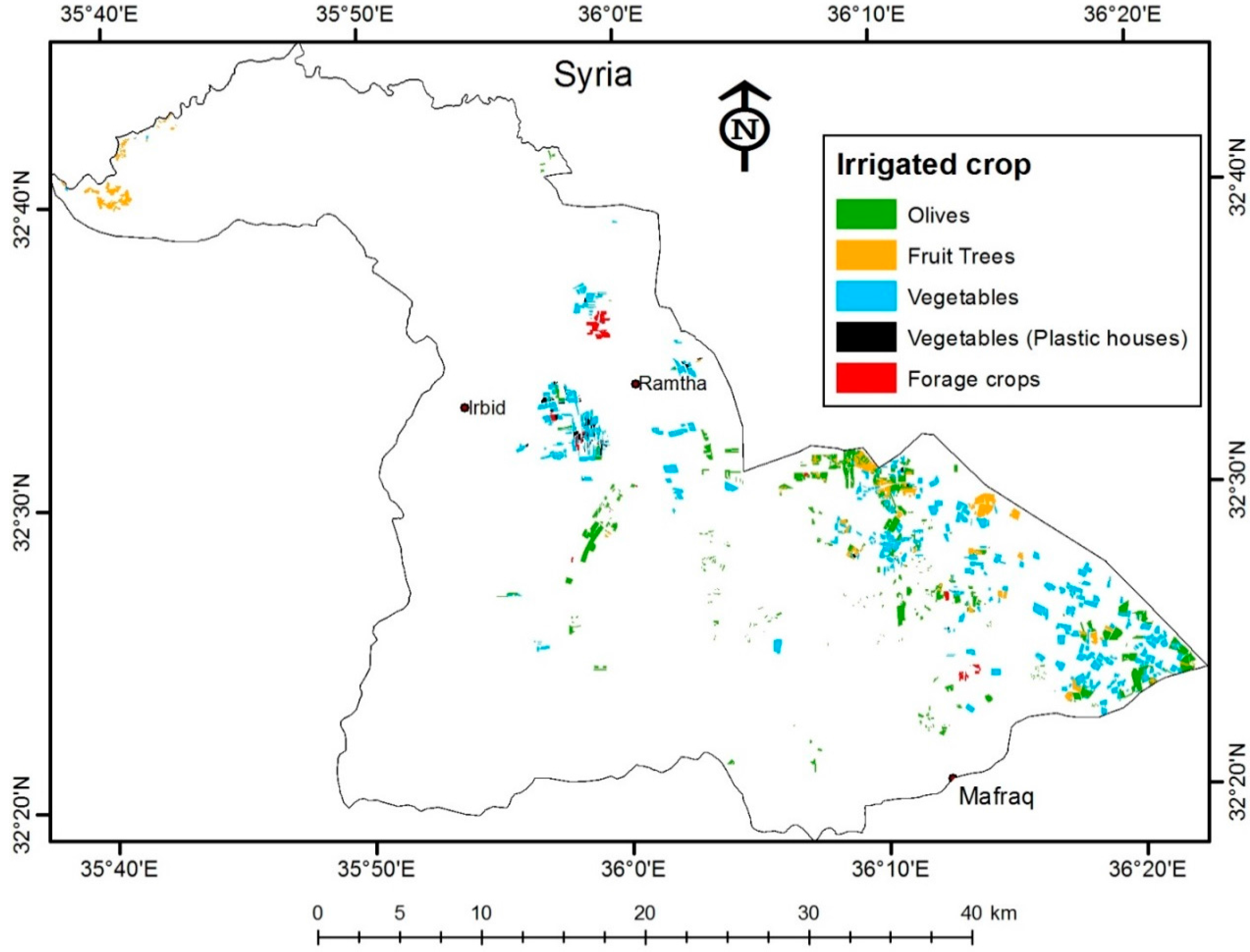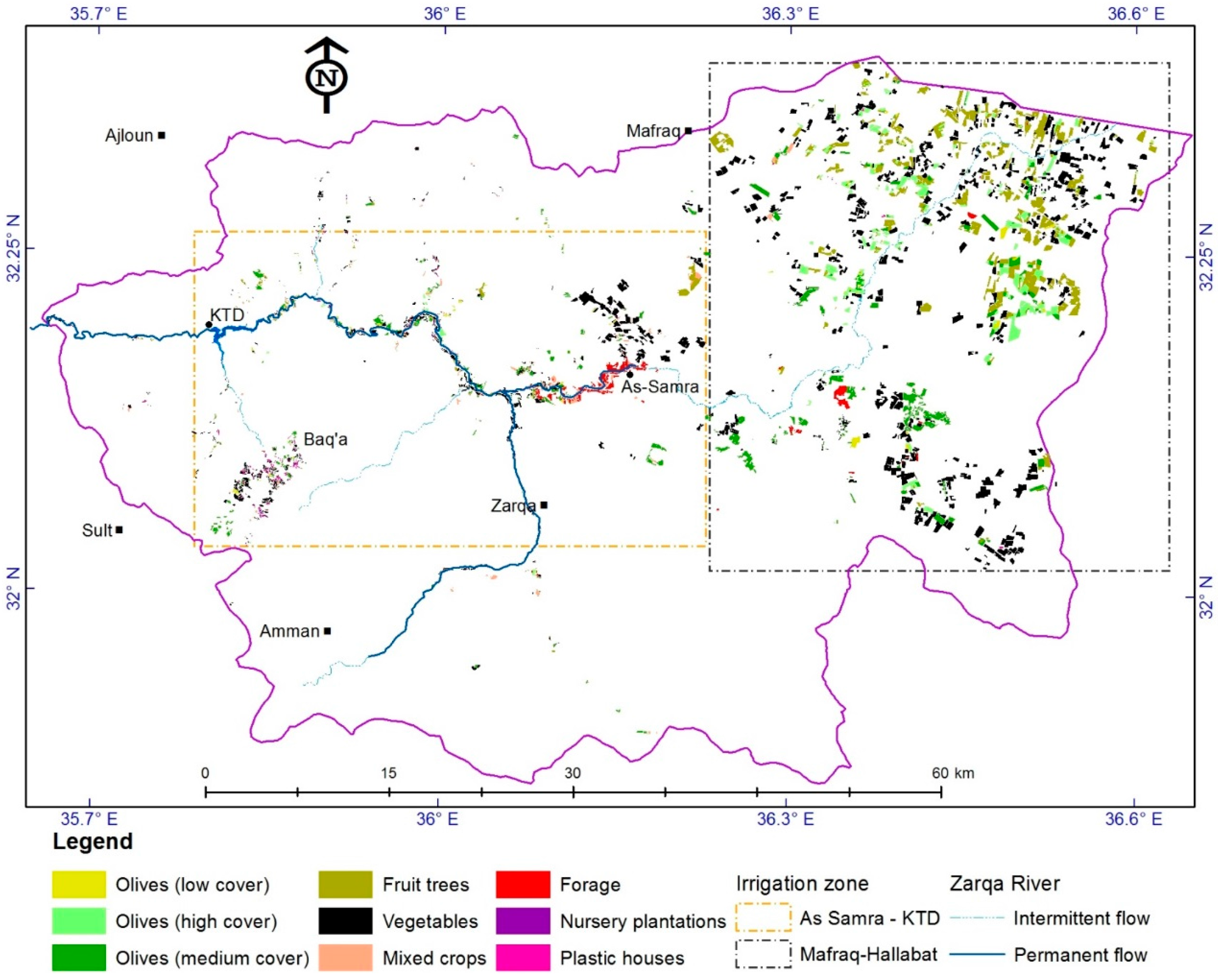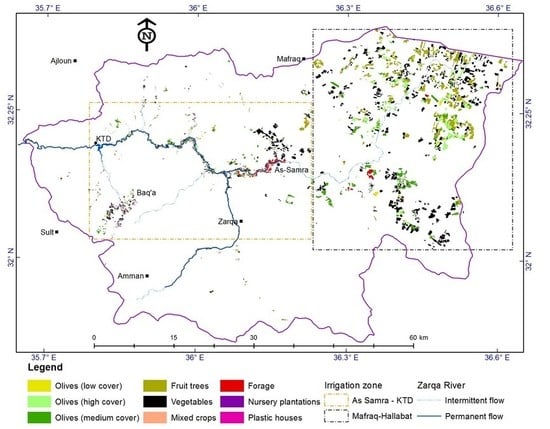1. Introduction
Drylands are limited by soil moisture due to low rainfall and high evaporation. They show a gradient of increasing primary productivity in the order of hyper-arid, arid, and semiarid to dry sub-humid areas [
1]. Drylands represent fragile ecosystems that are highly susceptible to environmental changes. Nevertheless, they provide important ecosystem services in terms of land and water, particularly in developing countries [
2]. The limited surface water resources of drylands makes water management a challenge for planners and decision-makers, as groundwater will be pumped for different uses to compensate for the limited surface water. The indiscriminate use of groundwater, particularly for irrigation, may result in aquifer depletion and salinization of soil and water. The problems resulting from groundwater depletion are usually aggravated in countries with high population growth and limited water resources [
3].
Among the countries of the Middle East, Jordan represents a challenging case in terms of dryland water management, as the country’s water resources are limited and its population is growing at high rates [
3]. In terms of water availability, Jordan is among the four poorest countries in the world, with a per capita share of less than 146 m
3 per year, which is far below the international water poverty line of 500 m
3 per year [
4]. Drylands dominate most of Jordan, where more than 90% of the country’s land is arid and receives low rainfall amounts (
Figure 1). Therefore, agricultural production in the country depends on irrigation using both developed surface and groundwater resources. At present, agriculture consumes more than 60% of the developed water resources. This share is expected to decrease in the near future as the population is increasing at high rates that reached an average of 2.9% during 2000–2012 [
3,
5]. According to Jordan’s Department of Statistics [
6], the population of Jordan increased from 5 million in 2002 to 6.7 million in 2014. The problem of population growth during 2002–2012 was aggravated by the influx of 0.45 and 1.5 million refugees from Iraq and Syria, respectively [
7,
8]. Such conditions of scarce resources and high population would put more stresses on water use and management. In addition, they might create environmental threats resulting from the use of marginal water resources [
9].
Managing water resources under the conditions of limited rainfall and increased competition among sectors requires updated information on water consumption by the different sectors. For domestic and industrial sectors, this can be achieved by the use of direct metering and information from pumping stations operated by the Government. For agricultural water use, the information on water consumption becomes more difficult when groundwater is used for irrigation. In Jordan, most of the figures on groundwater consumption for irrigation are inaccurate due to the lack of information on the actual irrigated area and crop water consumption. Information on the spatial distribution of irrigation with accurate areas for the different irrigated crops is still needed by the Ministry of Water and Irrigation (MWI) to assess and improve water management at the country level. The use of ground surveys to map irrigation is impractical, particularly when information is annually needed for water budget calculations and for revising plans of water management. Alternatively, remote sensing data and geospatial techniques can be used for this purpose. The improvements in spatial, spectral and temporal resolution of remote sensing data and the access to different sources of earth observation systems justify the adoption of geospatial techniques for managing water resources. The most important application in this regard is the use of medium and high resolution data to map crops and to estimate their evapotranspiration, the major component of crop water requirements or consumption use [
10,
11,
12,
13,
14].
The use of remote sensing and geospatial techniques in water management took a new turn as these techniques were utilized in new approaches of assessment, generally called water accounting systems [
15]. At the water basin level, the major components of these systems are the resource base, which represents water supply, crop evapotranspiration and water withdrawal, which represent water depletion, and the biomass production, which represents water productivity [
16,
17,
18]. The most important inputs provided by remote sensing to the abovementioned components are the crop evapotranspiration and the land use maps [
19]. The contribution of remote sensing and geospatial techniques will become more important in ungauged and poorly gauged basins as inputs will be provided with low cost and at reasonable accuracy [
19]. Whether water accounting systems are implemented or not, remote sensing and geospatial techniques will continue to support water managers and decision makers with information needed for improved water management.
Within Jordan’s efforts to manage its scarce water resources, MWI is in the stage of adopting geospatial techniques to improve water management at the country level. Recently, the MWI implemented a study in two pilot areas (Azraq and Mafraq) to map irrigated crops and to estimate agriculture water use using remote sensing data [
20]. Initial results of the study showed that remote sensing maps were more accurate than estimates and records obtained by field crews of MWI. The difference between actual and estimated areas was important in terms of water consumption. Although the differences between both estimates could be attributed to the non-extensive ground survey that was limited by the available resources, they could, however, indicate possible violations of illegal drilling of wells and inaccurate metering of pumped water [
21]. Therefore, the MWI adopted remote sensing for crop mapping and for auditing agricultural water consumption in the main irrigated areas in highlands. The areas included Jordan’s parts of Yarmouk, Amman-Zarqa and Azraq basins (
Figure 1). The overall aim of crop mapping using remote sensing data, presented in this work, is to provide MWI with information on the gap between official records and remote sensing estimates so that decisions can be taken to manage water resources in the three basins. Other objectives include the utilization of remote sensing data to map irrigated crops and the capacity building for MWI staff in using geospatial techniques for managing water resources. Despite their importance, spatial distribution of irrigated lands and their areas in Jordan were based on estimates, as the MWI lacked the capacity needed to fully utilize geospatial techniques. The inaccurate estimate of irrigated lands is also a worldwide problem and still remains uncertain [
22]. Furthermore, the political nature of irrigation in countries that share water resources across borders often sets the stage for under-reporting of water use [
23]. Therefore, this work provides proposed methods for mapping irrigated crops in Jordan’s drylands and similar environments and will thus help in downscaling irrigation mapping to the basin level and provide important information that can be used for auditing records of water abstraction.
2. Study Areas and Data Collection
2.1. Study Areas
The first basin considered in this study was Yarmouk (
Figure 1). About 30% (1393 km
2) of the basin’s land is located in Jordan, while 70% is located in Syria. The basin has a semiarid Mediterranean climate in the west and an arid climate in the east. A rainfall gradient is obvious across the east-west direction, where the mean annual rainfall is 600 mm in the west and 150 mm in the east. The rainy season starts in November and ends by early May. The mean annual minimum and maximum temperatures in the west are 12.3 °C and 23.1 °C, respectively. The mean annual minimum and maximum temperatures in the east are 9.3 °C and 24.0 °C, respectively. The western parts of the basin are mainly rainfed areas cultivated with field crops, olives and vegetables, while the eastern parts extend to the low rainfall zone of the country where irrigation occurs using groundwater. Irrigation also occurs around Ramtha and in the northern parts of Jordan valley where citrus and vegetable crops are cultivated.
The second study area where irrigation was mapped is the Amman-Zarqa basin, also known as the Zarqa River basin. The basin has an area of 3600 km2, where 95% of its area is inside Jordan and 5% is in the south of Syria. The basin has an arid climate in the east and the southeast, while the western parts have typical Mediterranean climates that are semiarid in Amman (Capital of Jordan) and dry sub-humid in Ajloun, where rainfall exceeds 560 mm. The western parts are mountainous and characterized by cool temperature in winter and mild temperature in summer. The annual rainfall ranges from more than 500 mm in the northwest to less than 100 mm in the east, with an average annual precipitation of 250 mm.
The third study area is Azraq basin (
Figure 1), which has a total area 11,742 km
2. In this basin, water drains from all directions to the center (depression), which used to be a permanent oasis in Jordan’s desert. The climate of Azraq Basin is arid with hot and dry conditions, leading to very high evapotranspiration rates. The mean annual temperature ranges between 7.4 and 24.5 °C in the west (Mafraq area) and between 2.6 to 36.6 °C in Azraq. The maximum air temperature in 2014 reached 42 °C. The mean annual rainfall is about 150 mm in the west and decreases to 70 mm in the east and south and to less than 50 mm in the center of the basin (Azraq depression). Over-pumping of groundwater for irrigation and drinking is noticed in this basin [
24,
25] and has resulted in the loss of wetlands surrounding the depression.
In terms of surface water resources, both the Yarmouk and Amman-Zarqa basins have perennial rivers that drain to Al-Wehdah and King Talal Dams (KTD), respectively. The collected water in both dams is used to irrigate different crops in Jordan Valley. Surface water resources in Azraq are mainly small desert dams that are used to irrigate small farms of olives and barley. Among the three basins, the Amman-Zarqa aquifer system is the most important groundwater supply in Jordan. This basin hosts more than half of Jordan’s population [
5] and more than 85 % of the industries in Jordan [
26]. Groundwater resources in Yarmouk and Azraq basins, on the other hand, are also used for drinking and irrigation. Other sources of water include the treated wastewater from different plants in the three basins. Part of the effluent from treated wastewater plants (WWTP) is used for restricted agriculture, according to agreements between MWI and local farmers. The annual amount of treated wastewater effluent in Amman-Zarqa basin is 98 million cubic meters (MCM). About 15 MCM are used for irrigating forage crops in the basin, while the remaining is mixed with stored rainfall water in KTD and used to irrigate crops in Jordan Valley. The total amount of treated wastewater allocated for irrigation in Yarmouk is 3.8 MCM.
Table 1 summarizes available water resources in the three basins and their use in 2014. All of the above figures were used in calculating gross groundwater amounts used for irrigation. In addition to over-pumping, other threats to water resources in the three basins are the trends of climate change, droughts and desertification [
3,
27,
28,
29].
2.2. Remote Sensing Data
The main data used to map crop types were the images of the Operational Land Imager (OLI) of Landsat 8. The images have medium spatial resolution of 30 m. A higher resolution data of RapidEye, with 5-m pixel size, was used to delineate parcels of irrigated fields. The OLI data covered the period October 2013–September 2014, corresponding to a one-year period for calculating the water budget by the MWI. The data of RapidEye included two sets of cloud free images acquired in May and August 2014. Specifications of Landsat and RapidEye bands (B) used in the study are shown in
Table 2.
2.3. Ground Data
Ground surveys were conducted during May–October 2014 to collect data on the different irrigated crops in the three basins. During these surveys, information was collected on the types of crops, growth stage, planting and harvesting dates, in addition to irrigation systems and agricultural management followed for the different crops. This information was critical for verifying crop maps and for calculating water consumption for irrigated crops in the three basins. In total, field surveys covered 310 farms in the three basins.
Other ground data were collected for atmospheric correction of OLI images. Since remote sensing data of Landsat 8 were provided in digital numbers (DN) corresponding to radiance values at the top of atmosphere, it was important to convert the data into reflectance values at ground level. For this purpose, a handheld multispectral radiometer was used to collect ground measurements for target objects with standard or reference reflectance. The target objects were newly paved car parks (Dark objects) in front of Azraq Syrian Refugees Camp, dry desert mud flat, fields of parsley and tomatoes with full vegetation cover and bright surfaces (floors of abandoned quarries and desert surfaces). The selected locations were large enough so that they appeared in the form of several pixels on the images. Collection of ground data with the handheld radiometer was carried out within one hour of the satellite overpass on the 30 June 2014. The Landsat 8 image acquired for the day in which measurements were made was LC81730382014181LGN00.
2.4. MWI Data
Data of air temperature, relative humidity, wind speed and solar radiation were provided by the MWI. The data included daily records for the stations of Azraq, Safawi Um Ejjmal in Mafraq, Khirbet Samra, KTD, Amman, Ramtha and Irbed. The data were arranged in a spreadsheet and processed to interpolate missing records before being used for calculating crop water requirements. In addition, the MWI provided maps of groundwater wells, with attributes that included amounts of monthly abstraction, in addition to data on irrigated crops and crop management practices in Azraq and Amman-Zarqa basin. The data, originally collected from members of the highland water forum [
30], were used for calculating crop water requirement and for verifying crop maps.
3. Methodology
Geospatial techniques and remote sensing data can be used for mapping irrigated lands at local, regional and global scales, according to objective, cost and time. The methods for crop mapping at local scales would include the visual interpretation or a digital classification method or a combination of both [
10]. The improvement in remote sensing data encouraged researchers to implement and adopt digital classification methods, which are cost effective and consume less time when compared with the visual interpretation method [
31]. The most commonly used approaches of digital classification include the parametric methods of supervised and unsupervised clustering [
32]. These methods depend on the use of a single image acquired during the period of peak growth of crops. Due to multi-cropping and varying cropping calendars, a single image may not adequately characterize irrigated areas [
33]. More advanced techniques may implement decision tree classifications, which are based on ground data, in addition to knowledge and experience of the classifier [
10,
34,
35]. Further, the use of multi-temporal images of vegetation indices will increase the accuracy of mapping, as temporal resolution may compensate for the poor or moderate spatial resolution [
10,
36,
37]. Among vegetation indices, the normalized difference vegetation index (NDVI) is considered a useful remote sensing product for mapping irrigation at local scales [
36,
37]. In this study, crop identification was based on the outputs from digital classification techniques of multi-temporal images of Landsat 8 (
Figure 2), while boundaries of irrigated fields were digitized from very high resolution images of Google Earth (GE) and RapidEye (
Figure 3), as described in the following subsections.
3.1. Processing of Remote Sensing Data
The set of downloaded images was processed to identify and exclude images with high cloud cover. A cloud mask was applied to each image using open source software [
38]. Using the capabilities of a geographic information system (GIS), each image derived from the cloud mask was decoded using reclassification functions. The output images of cloud cover were displayed and processed in GIS to interpolate cloudy pixels in each image from previous and subsequent images. The total number of OLI images was 23 per year. However, the images with good quality and minimum cloud cover were only ten for Azraq and twelve for the two other basins. For the period of irrigation during April–September, most of images were free of clouds.
Remote sensing data of OLI were corrected to obtain reflectance values at ground level. This was carried out using measurements from the handheld multispectral radiometer (with similar spectral regions to OLI). The data of the handheld radiometer were used for correcting one image (Day 181 of year 2014). This absolute atmospheric correction was based on empirical line calibration [
39] derived from linear equations that correlated ground measurements of spectral reflectance with DN for locations of target objects that had unchangeable spectral reflectance among the set of OLI images. The multiple-date image normalization, using linear regression equations, was carried out to correct other images [
40]. This relative atmospheric correction method was based on the use of invariant features that had unchangeable spectral reflectance among the set of OLI images. Both methods of absolute and relative atmospheric corrections were considered as standard methods that would not require information about atmospheric conditions at the time of image acquisition [
41]. The correction was carried out for the red and near infrared bands of OLI. The corrected bands were then used to derive NDVI, based on the following equation:
where B4 and B5 are the red and near infrared bands, respectively. Both bands represent spectral reflectance at ground level. The steps of processing OLI images to derive NDVI are summarized in
Figure 2.
3.2. Extraction and Analysis of NDVI Profiles
Observations collected during ground surveys were transferred into a GIS layer, representing points with different types of irrigated crops. The map was intersected with the layer of NDVI images to assign NDVI values for each crop type in the form of a profile that represented temporal changes in this index during the year. Examples of these profiles for Azraq are shown in
Figure 4. The data of NDVI profiles were exported to spreadsheets and NDVI values were plotted for growing seasons. Statistical functions were applied in the spreadsheets to identify ranges of NDVI and to aid in building a decision tree for creating crop maps. Analysis of NDVI profiles showed that separation of the irrigated crops was possible with the use of multi-temporal images. NDVI profiles showed that alfalfa was characterized by the highest NDVI that reached its maximum theoretical value (1.0), with fluctuations resulting from crop cutting. Olives, on the other, had stable NDVI profiles (with a nearly constant value that was slightly above 0.50 for old plantations). Younger olives (3–4 years) had a straight line NDVI that was in the range of 0.20 to 0.30. The profiles for vegetables varied according to crop type and growing season, with peak NDVI values occurring during the midseason for each vegetable crop.
Following the stage of NDVI extraction and analysis, decisions were developed to identify the NDVI ranges (bounds) for each crop and for each time of the season. These decisions were mainly developed for Azraq and Amman-Azraq basins, while for Yarmouk, the unsupervised classification method was used to separate rainfed from irrigated areas. The NDVI range for each vegetable crop was based on the mean and standard deviation for NDVI image, as profiles of NDVI showed normal distribution patterns during the growing seasons. For alfalfa and olives, the range was modified according to the degree of agreement between classified pixels and ground observations. The NDVI profiles were also used to identify the length of the growing season, which was crucial for calculating crop evapotranspiration. Based on ground observations and analysis of NDVI, a classification scheme (
Table 3) was adopted for mapping the different irrigated crops. The scheme included the different classes and sub-categories that included all irrigated crops and growing seasons in the three basins.
3.3. Mapping Irrigated Fields
Parcels of irrigated fields were mapped using an on-screen digitizing process with high resolution images of RapidEye and images of GE as backgrounds for delineation. The GE images were very useful as they had very high spatial resolution and horizontal accuracy that could reach 1 m [
42]. RapidEye images, on the other hand, provided recent data that covered irrigated lands in year 2014, while GE images were mainly used in separating tree crops from vegetables. Identification of crop type, on the other hand, was based on outputs from the unsupervised classification of the multi-temporal images of Landsat 8 OLI. For Azraq and Amman-Zarqa basins, crop identification was carried out by the application of models that included decisions based on NDVI ranges derived from the multi-temporal images. The decisions were based on conditional statements that identified the range of NDVI for each crop and for each date in the set of the multi-temporal images of OLI. The models were applied in a sequence that prioritized crops according to their proportions, as observed during ground surveys. Subsequently, the sequence of models started with olives, followed by vegetables, fruit trees and other crops.
In Yarmouk basin, initial results showed some mixing between rainfed and irrigated areas. Therefore, principal component analysis (PCA) was used to transfer NDVI images of Yarmouk into three principal components. Applying the PCA to NDVI images resulted in transferring these images into three principal components that accounted for all seasonal changes in NDVI, as indicated by previous research [
43]. Results from the unsupervised classification of PCA showed six distinguished spectral classes. The PCA images were then incorporated into unsupervised classifications with the ISODATA algorithm to derive spectral classes of irrigated and rainfed areas in this basin. Visual inspection of the output image showed that irrigated areas were distributed among three out of the six classes. In order to increase accuracy of mapping, models of knowledge based classifiers were used to refine the map of irrigated crops by incorporating layers of digital elevation model (DEM), rainfall and images of minimum NDVI values in these models. The DEM was used to exclude areas with high altitudes, where Jordan’s forests were located. A rainfall map was used to exclude areas with high rainfall, as rainfed agriculture was dominant in these locations. The map of minimum NDVI separated irrigated areas from natural vegetation in the low rainfall zone. Accuracy assessment was made for the output maps using the confusion-matrix method [
44], which compared remote sensing results with observations collected during ground surveys.
3.4. Assessment of Groundwater Abstraction Records
Assessment of groundwater abstraction for irrigation would require the use of ground measurements to compare amounts of abstraction with crop water consumption. Ground measurements of crop water requirements, however, are time consuming and become very expensive for large geographical areas. Therefore, crop water requirements can be calculated using crop maps and meteorological data. Remote sensing techniques can also provide spatial estimates of crop evapotranspiration (ETc), which is the main component of net crop water requirements (NCWR). This can be achieved by the surface energy balance models that utilize remote sensing data to derive the main factors controlling water evaporation from soil and plants and thus calculate ETc [
45]. These models, however, require validation before being adopted for calculating ETc [
46]. Therefore, crop maps were utilized in this study to calculate the crop ETc using the standard method of Food and Agricultural Organization [
47]. The other component included in calculations of NCWR was the salt leaching requirement, which depended on water salinity and crop type. Rainfall in Yarmouk and Amman basin was also considered in these calculations. The FAO56, based on Penman-Monteith method, was used to calculate ETc as follows [
47]:
where ETc is the actual crop evapotranspiration (mm); Kc is the mean monthly crop coefficient; and ETo is the grass reference evapotranspiration. The NCWR, in million cubic meters (MCM), was calculated by multiplying the seasonal ET of the crop with its corresponding area, taking rainfall into consideration.
The FAO56 method calculates the theoretical crop water requirements and assumes standard conditions of crop spacing, ground cover and growing periods. These assumed conditions might not be valid in all fields in the three basins. Therefore, crop spacing and cover were considered in the calculations by adjusting Kc values based on ground cover fraction [
48]. Ground cover was derived from the high resolution images of GE (
Figure 3) and the data collected during ground surveys. The length of each growing stage was adjusted from NDVI profiles (
Figure 4), which showed some differences between the values reported by the FAO56 method and the actual growing periods. Following this step, daily weather records of MWI were used to calculate ETo using an ETo calculator, developed by FAO [
49]. The outputs of daily ETo were summed for each month to calculate monthly ETc. Values of Kc were adjusted using NDVI profiles and data collected during ground surveys. The adjustment was made according to ground cover and used a linear interpolation to derive monthly Kc. Irrigation efficiency was used to convert the NCWR to gross crop water requirements (GCWR). The average irrigation efficiency in the three basins was about 80% [
50]. The calculated GCWR were compared with the records of groundwater abstraction for irrigation purposes to assess the compliance between the recorded abstraction in relation to crop water requirements and safe yields in the three basins. For vegetables cultivated in plastic houses and nurseries, the GCWR were given an average value of 800 m
3 per year, based on the average for tomato [
51,
52] for two cultivations per year.

